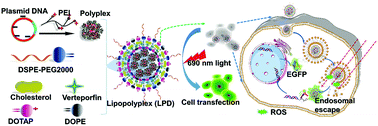Photoresponsive endosomal escape enhances gene delivery using liposome–polycation–DNA (LPD) nanovectors†
Abstract
Lipid-based nanocarriers with stimuli responsiveness have been utilized as controlled release systems for gene/drug delivery applications. In our work, by taking advantage of the high complexation capability of polycations and the light triggered properties, we designed a novel photoresponsive liposome–polycation–DNA (LPD) platform. This LPD carrier incorporates verteporfin (VP) in lipid bilayers and the complex of polyethylenimine (PEI)/plasmid DNA (pDNA) encoding EGFP (polyplex) in the central cavities of the liposomes. The liposomes were formulated with cationic lipids, PEGylated neutral lipids and cholesterol molecules, which improve their stability and cellular uptake in the serum-containing media. We evaluated the nanocomplex stability by monitoring size changes over six days, and the cellular uptake of the nanocomplex by imaging the intracellular route. We also demonstrated that light triggered the cytoplasmic release of pDNA upon irradiation with a 690 nm LED light source. Furthermore, this light triggered mechanism has been studied at the subcellular level. The activated release is driven by the generation of reactive oxygen species (ROS) from VP after light illumination. These ROS oxidize and destabilize the liposomal and endolysosomal membranes, leading to the release of pDNA into the cytosol and subsequent gene transfer activities. Light-triggered endolysosomal escape of pDNA at different time points was confirmed by a quantitative analysis of colocalization between pDNA and endolysosomes. The increased expression of the reporter EGFP in human colorectal cancer cells was also quantified after light illumination at various time points. The efficiency of this photo-induced gene transfection was demonstrated to be more than double compared to non-irradiated controls. Additionally, we observed a reduced cytotoxicity of the LPDs compared with the polyplexes alone. This study has thus shown that light-triggered and biocompatible LPDs enable an improved control of efficient gene delivery, which will be beneficial for future gene therapies.



 Please wait while we load your content...
Please wait while we load your content...
